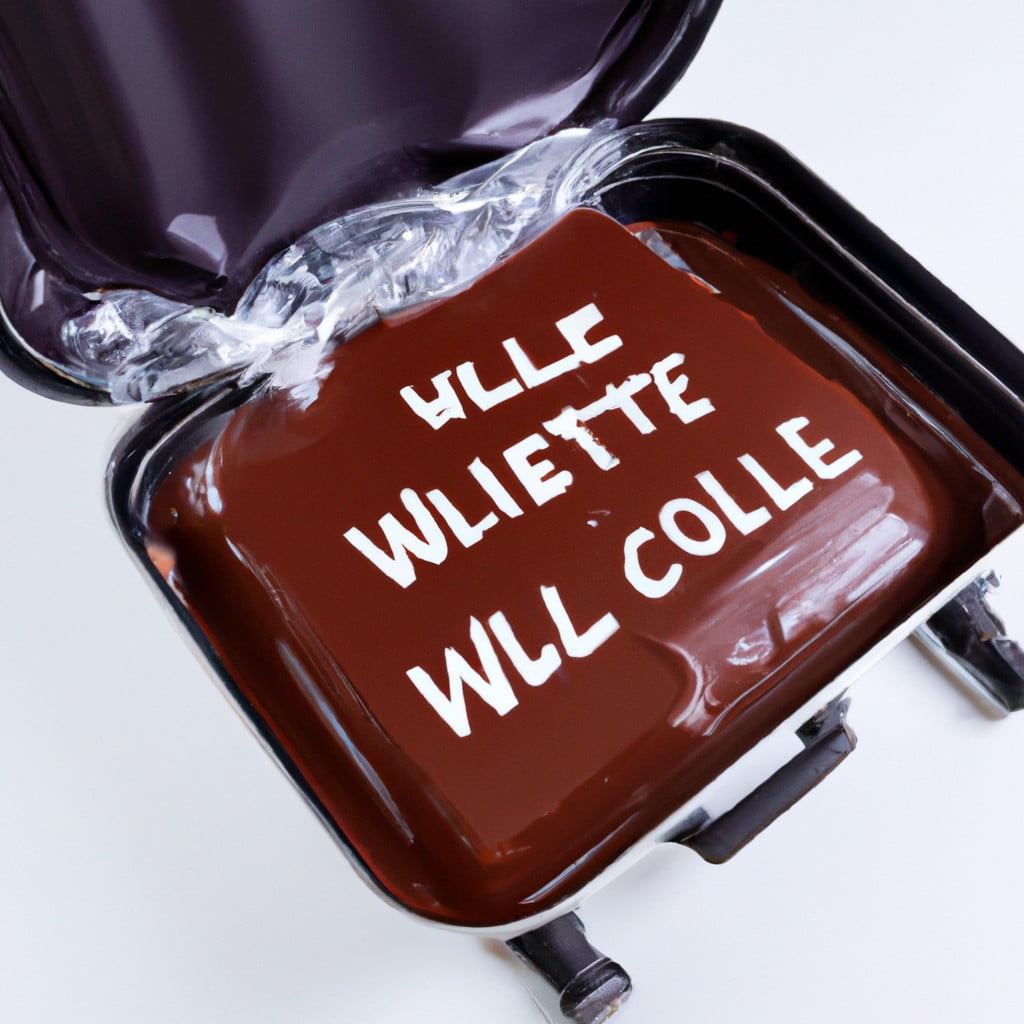Exploring whether chocolate will melt in checked luggage offers insights into the considerations for traveling with this delightful treat.
Traveling with chocolate in checked luggage can pose a risk of melting, primarily due to the varying temperatures it may be exposed to during the journey. However, with the right precautions, it’s entirely possible to transport your sweet treats without a mess.
This article will guide you through the potential temperature variations in the cargo hold, the melting points of different types of chocolates, and share practical tips on how to pack your chocolate to prevent it from melting.
Keep reading to ensure your chocolate arrives in perfect condition at your destination.
Key takeaways:
- Chocolate has different melting points based on type and form.
- Factors contributing to chocolate melting include temperature, duration of exposure, and type of chocolate.
- Packing strategies include insulated bags, thermal bubble wrap, and placement in the middle of the suitcase.
- Declare chocolate in checked luggage when traveling internationally.
- Consider alternative options like cooled shipping services or buying chocolate upon arrival.
Inside
Understanding Chocolate Melting Points

Chocolate, in its various forms, reacts differently to heat. Pure, dark chocolate typically begins to soften around 90°F and fully liquefies at about 115°F. On the other hand, milk chocolate, with the inclusion of milk powders or solids, has a slightly lower melting point, often starting to soften around 85°F and melting entirely near 105°F.
White chocolate, although not containing cocoa solids, behaves similarly to milk chocolate due to the presence of cocoa butter, softening at approximately 85°F and liquefying by 110°F.
Substitutes often branded as “chocolatey,” usually contain vegetable fats instead of cocoa butter, boasting a higher resistance to heat, some even resisting melting up until 130°F.
The form of chocolate also impacts how it handles heat. Chocolate chips, designed to withstand oven heat when baking, contain less cocoa butter and therefore take longer to melt than a chocolate bar of the same type.
Factors such as the presence of other ingredients or additives (like fruit, nuts, or caramel), the chocolate’s shape and mass, and the method of storage can also affect how quickly or slowly chocolate may melt.
Factors That Contribute to Chocolate Melting in Luggage
Several elements contribute to the melting of chocolate in checked luggage. First is the temperature. The average melting point of chocolate is around 86-90 degrees Fahrenheit, and sometimes the hold area of the airplane can exceed these temperatures.
Next, the duration of the flight and the temperature exposure time matters. The longer the chocolate is subjected to high temperature, the more it’s likely to melt.
Heat sources in the luggage or close proximity to hot objects could also lead to melting. Electronics or other heat-generating items packed in the same bag may cause the temperature inside the luggage to rise.
Lastly, the type of chocolate plays a role. Dark chocolate, which has a higher cocoa content, might withstand higher temperatures compared to milk or white chocolate.
Considering these contributing factors, it’s better to take precautionary steps, like insulating the chocolate or keeping it close to cooler items. However, these measures cannot guarantee that the chocolate will stay solid due to varying temperatures in the airplane hold.
Chocolate Protection Strategies During Transit
Opt for a temperature-controlled shipping service specifically designed for perishable items. These services ensure the chocolate stays at an optimal temperature throughout the journey.
Pack the chocolate in a cooler or insulated bag. Include frozen gel packs or dry ice to keep the temperature down. If using dry ice, ensure proper handling as it can be dangerous if not used correctly.
Consider using thermal bubble wrap. This material insulates against heat and is ideal for packaging chocolate to prevent melting.
Wrap the chocolate in aluminum foil followed by a ziplock bag. This additional layer aids in maintaining the chocolate’s temperature and protects against any unintended spillage from other items in the luggage.
Place the packaged chocolate in the middle of the suitcase, surrounded by clothing or other soft items. This placement provides extra insulation and minimizes the risk of the chocolate being damaged by impacts during transport.
Avoid packing the chocolate in luggage that will be stored in the plane’s cargo hold, if possible. The hold may experience critical temperature variations that can cause the chocolate to melt. Carry-on luggage is a safer option as the temperature in the aircraft cabin is regulated.
Kindly note, it’s crucial to realize that these steps do not provide a foolproof guarantee against melting, especially in warm weather conditions. Planning and taking preventive measures can significantly reduce the chance of a chocolate disaster.
Declaration of Chocolate in Checked Luggage
When travelling internationally, it’s crucial to declare the presence of food items, which does include chocolate, to avoid potential fines or confiscation at customs. Here are some important notes on what to do:
First, locate your country’s Customs Declaration form, which can typically be found online or provided in-flight. Look for a field related to carrying food items.
Secondly, always lean towards declaring your items even if you are unsure. Customs agents are there to control the importation of goods that pose a risk to local agriculture, and while chocolate isn’t typically a risk, rules can vary by country.
Lastly, be prepared for a possible inspection. Pack the chocolate in an accessible place in your luggage as inspectors might ask to see it.
Following these steps will reduce the chance of a hold-up at customs. You get to enjoy your chocolate, and the customs officials appreciate your transparency in making their job easier.
Potential Impact of Warm Climate On Chocolate
Warm climates pose a considerable risk to chocolate during transit. The heat substantially elevates the possibility of melting, more so if there’s prolonged exposure.
Chocolate begins to soften around 27°C (80°F) and can entirely melt at temperatures reaching around 32°C (90°F).
If your destination is notoriously warm or experiencing a heatwave, chances of chocolate melting in your luggage considerably increase.
Warm atmospheres aren’t solely limited to the outside environment. Holding areas for luggage, such as those in airports, can also reach high temperatures.
The duration of the journey significantly contributes to the likelihood of chocolate deterioration. A short flight might not be problematic, but a long-haul flight increases the risk of melting.
To deal with these challenges, consider taking steps such as wrapping the chocolate in insulated materials or placing it with cold packs to help maintain a cooler temperature. Using airtight containers can also help to avoid mess in the case the chocolate does melt.
Effects of Delayed or Lost Luggage On Chocolate
When luggage is delayed, the risk factor for your chocolate increases. Here’s why:
- More Time Exposure: The longer chocolate stays in unfavorable conditions, the higher the chance of it melting.
- Temperature Uncertainty: With delayed luggage, it’s difficult to account for the various environments your luggage may be subjected to.
- Uncontrolled Circumstances: Luggage may end up sitting in a sun-baked cargo area or a hot tarmac, ideal conditions for chocolate to melt.
In the case of lost luggage:
- Risk of Incorrect Storage: If your luggage is lost, and consequently stored by the airline, it’s unlikely they will store your luggage in a temperature-controlled environment favorable to chocolate.
- Deterioration Over Time: If the luggage isn’t found immediately, the prolonged heat exposure could lead to the chocolate not just melting but also deteriorating in quality.
You can take the following preventative steps:
- Use Insulated Packing Materials: Thermally insulated packaging could help maintain the chocolate’s temperature.
- Opt for Express Delivery: If possible, choosing express handling reduces the time the chocolate spends in potentially risky zones.
Remember, prevention is the best strategy when it comes to protecting chocolate in your luggage.
Alternative Options to Transport Chocolate Safely
Utilizing a cooled shipping service when sending chocolate over long distances can maintain its quality. Many companies specialize in shipping perishable items, typically using ice packs and insulated containers.
Carrying chocolate in hand luggage rather than checked luggage often increases chances of it maintaining perfect condition. This allows direct control over the product environment, reducing the risk of it being subjected to high temperatures in the aircraft’s baggage hold.
When traveling, buying chocolate upon arrival rather than packing it can be another solution. This avoids exposing chocolate to extreme conditions during transport.
Packing chocolate in a cooler or thermal-insulated bag with cool packs ensures regulated temperatures. But it’s crucial to ensure cool packs are airline-approved and meet their size limitations.
Using a chocolate travel carrier offers protection for specific types of chocolate. Various designs are available to cater to different chocolate bars and bonbons.
Opting for sturdier types of chocolate like certain dark chocolates or chocolate-dipped confections can endure higher temperatures without damage. These types of chocolates have higher melting points and resist heat better.
FAQ
How do you keep chocolate from melting in checked luggage?
To prevent chocolate from melting in checked luggage, encapsulate it within insulating materials like bubble wrap, wax paper, or aluminum foil, ensuring that all openings are securely sealed to inhibit the intrusion of warm air.
Is it OK to put chocolate in checked luggage?
Yes, it is permissible to put chocolate in checked luggage as it is categorized as a solid food item.
Will chocolate melt in my suitcase on the plane?
Chocolate generally won’t melt in your suitcase on an airplane, but for complete assurance, you may want to store it in your carry-on case.
How do you take chocolate on a plane without it melting?
To ensure chocolate doesn’t melt while traveling on a plane, keep it at room temperature or, if it’s a particularly hot day, place it near a small bag of ice.
What type of packing materials can prevent chocolate from melting in checked luggage?
Insulated cooler bags, frozen gel packs, and thermal bubble mailers are effective packing materials to prevent chocolate from melting in checked luggage.
What are the risks of transporting chocolate in checked luggage during summer months?
The risks of transporting chocolate in checked luggage during summer months include potential melting due to high temperatures and damage from rough handling.
Can cabin temperature variations on an airplane affect the state of chocolate in checked luggage?
Yes, cabin temperature variations on an airplane can affect the state of chocolate in checked luggage, potentially leading to melting or bloom.




